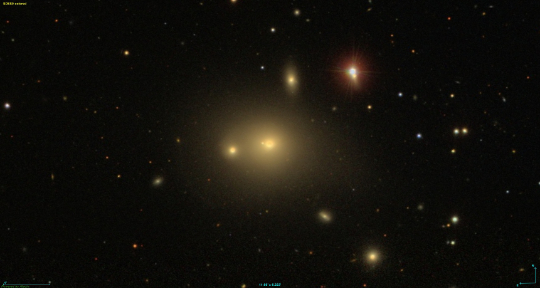September 2016 - Galaxy of the Month
NGC 741 in Pisces
This interactive image of the NGC 741 group was provided by the Sloan Digital Sky Survey using Aladin Sky Atlas. We also have a finder chart should help you locate these galaxies.
The galaxy pair NGC 741 and 742 were first discovered by William Herschel in December 1784 using his large 20 foot telescope. They are part of a small group of galaxies listed as WBL 61 which, along with NGC 741 and 742, also contains the galaxies UGC 1425 and 1435 along with a couple of anonymous small galaxies.
The group does have some nomenclature confusion (as always) in the NGC/IC as a small galaxy close by the main pair is listed as IC 1751 and displayed as such in star charting programs such as Megastar and SkyTools. It is now known that in fact IC 1751 is a duplicate observation of NGC 741 and the galaxy formerly known as IC 1751 should now be called MCG 1-6-6. It is also part of the WBL 61 group.
The main pair of galaxies appear to be interacting and probably had a collision a few 10’s of million years ago. It is likely that this interaction between NGC 741 and NGC 742 took the form of an almost head on collision.

NGC 741 would also appear to be an inactive AGN as it shows an old faint radio lobe. There appears to be both a radio and an X-Ray filament linking NGC 741 and NGC 742 as well as a hot gas bubble in the group. Both NGC 741 and 742 show point radio sources at their core which suggests the collision was not too disruptive. The results of the collision mirror the optical remnants of the more well-known Taffy Galaxies UGC 12914/12915.
In terms of group morphology NGC 741, NGC 742 and MCG 1-6-6 are all elliptical galaxies. UGC 1425’s type is unknown but it is probably either an elliptical or lenticular whilst UGC 1435 is probably a spiral galaxy. The interacting pair NGC 741/742 are also known as VV175. NGC 741 is a giant elliptical galaxy that appears to be the centre of a group of approximately 40 galaxies in total. The deep SDSS image shows a lot of faint galaxies in the area.
Visually NGC 741 should be seen in perhaps 20cm but to see NGC 742 will require probably 30cm and a high power to separate from NGC 741. To get the third member of the triplet MCG 1-6-6 will probably require a telescope in the 40cm class and good skies. The two fainter galaxies may just appear as stellar spots. NGC 741 is also part of the Herschel II list from the AL. I suspect that to pick up the UGC galaxies visually, especially from the UK, will require 50cm aperture or better.
Owen Brazell - Galaxy Section Director
A few of our members have provided observations for this field.